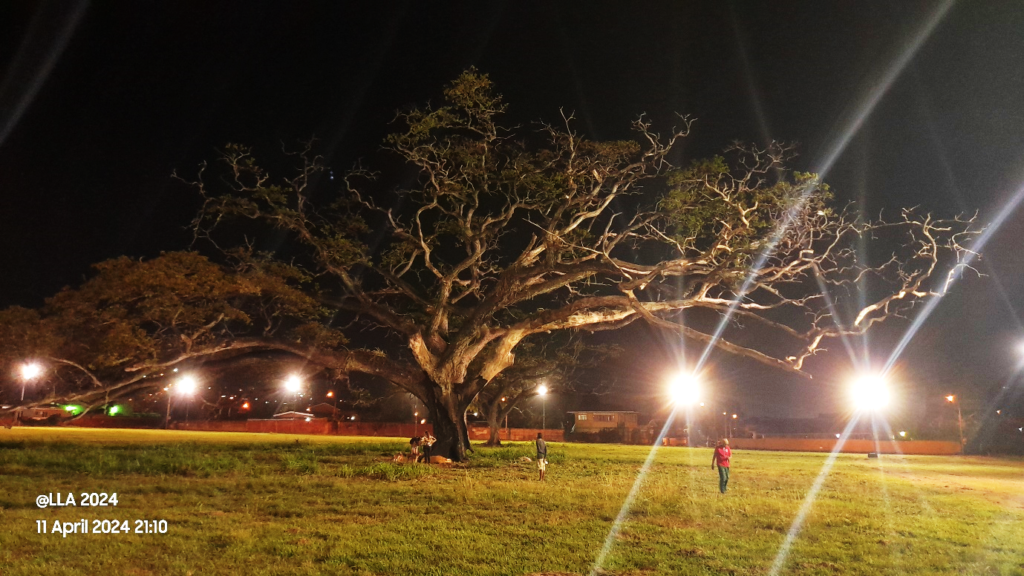Trekking through the waterways, lying on the cold, lush green grass, and gazing through the canopy of the majestic trees at the Aranguez Savanna was a cherished memory of my childhood. This past Thursday, along with Linton Arneaud and Dan Jaggernauth, I visited the savannah with a heavy heart, drawn there by a plea to help two old friends – the Saman trees on the Eastern side.
Dominika Justine Tux- the founder of the charity Lost & Found Association Trinidad and Tobago, and scientist for media and communication, musician and multimedia artist noticed the decline of these majestic giants and reached out to Linton for assistance. In the dark of the night, their silhouettes tower against the sports field lights but these weren’t the vibrant trees I remembered (Figure 1). These trees, likely close to a century old, had witnessed countless moments of joy – games played with cousins under their watchful branches, picnics enjoyed in their dappled shade. The Saman, also known as the rain tree or monkey pod, is a familiar sight across Trinidad. Renowned for its expansive, umbrella-like canopy offering cooling shade, it’s a haven for both humans and wildlife. It offers countless benefits – ecological, cultural, and aesthetic.

Figure 1. One of two distinguished Saman trees at the Arnaguez Savana. Once majestic, they are now fighting for their lives, recovering from deadly fires set by humans.
Sadly, upon closer inspection, the reality of the situation became clear. Fire damage, reportedly caused by homeless persons, had significantly compromised the trees’ health, compounding the damage done to one of the trees when it was struck by lightning years ago. Roughly 80% of each tree was dead, with fallen branches and rotting roots. What a bleak picture! Dominika had been diligently caring for the trees despite the setback.
Linton’s expertise confirmed our fears. The fire had severely damaged the phloem, the vital tissues surrounding the trunk of the trees which is responsible for transporting nutrients throughout the plant (Figure 2). Their attempt to regenerate this crucial layer was a valiant effort, but with limited resources, the prognosis was fatal. Dan and Linton both expressed concern that the remaining branches would likely plummet, especially with the strong winds predicted to accompany the upcoming rainy season.

Figure 2. Evidence of repeated burning on the trunks of the Saman trees highlights the severity of the accumulative damages.
In 2015, another magnificent Saman tree collapsed on the western side of the Aranquez Savannah. Today, I had the bittersweet opportunity to revisit my familiar friends, before their departure. Saying goodbye to these giants is a poignant reminder of the passage of time, and the impermanence of even the most familiar landmarks. The Aranguez Savanna will feel desolated without their presence. Yet, the memories they hold will forever be etched in my heart.
Dominika, ever the optimist, held onto a sliver of hope. Perhaps, she mused, the trees could shed the unsalvageable portions, retain the healthier parts, and one day rebuild their majestic crowns. However, Linton and Dan, while cautious, did offer helpful advice for moving forward. Additionally, they encouraged Dominika to think about planting new Saman seedlings at the beginning of the rainy season to start the cycle anew. Against the odds, Dominika and her team continue to care for the trees, we wish them the best.
This experience also provides a stark reminder of the importance of protecting our natural heritage. We need to be mindful of future generations by protecting our natural treasures.
As we turned our backs to head home, Linton sadly reminded us that losing these giants meant losing not just a landmark, but also some of the very air we breathe.